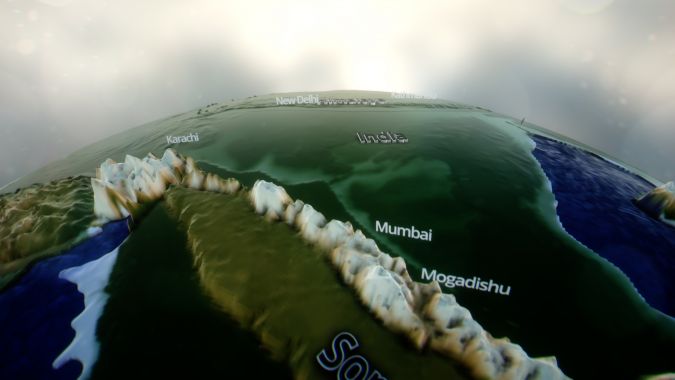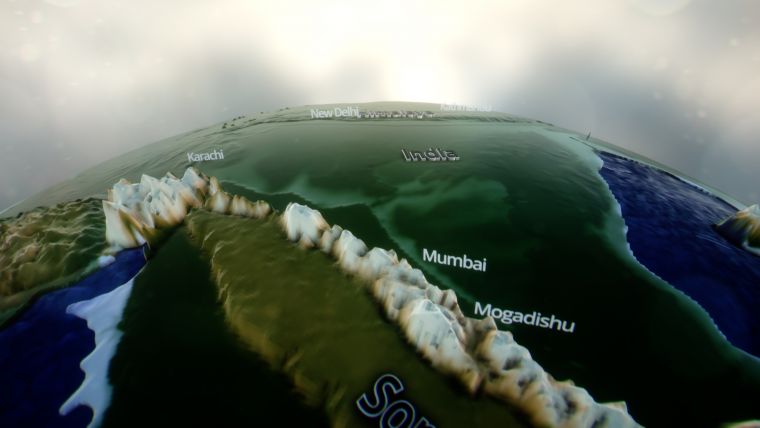Shaping the Mountains of the Future
The Collision of India, Somalia and Madagascar
Is it possible to predict the mountains of the future? This stunning 3D animation shows the Somalaya Mountains – an enormous mountain range that does not yet exist, but will be formed when Somalia, Madagascar and India will collide in around 200 million years' time. The researchers believe that predicting the geological future based on the present can help us to better understand the past.
Journalists occasionally ask Dutch geologist Prof Douwe van Hinsbergen if it is possible to predict the mountain ranges of the future. His usual answer: “Yes, but why would I? I’d have to wait millions of years to see if I’m right”. Over time, however, he came to realize that it wasn’t such a strange idea. “If we understand what happens as mountains are formed in the future, then we’ll have a better understanding of how our current geography developed.” So he drew up a series of ‘rules’ – the first in the world – to describe how mountain ranges will look in the future. “In the next supercontinent, around 200 million years in the future, Somalia, Madagascar and India will collide with each other, thereby creating the Somalaya Mountains.” These rules could serve as a stepping stone to a lot of fundamental studies into the origin of ores, the occurrence of earthquakes, or past changes in the climate. The formation of the Somalaya Mountains can be seen in the animation called 'Mountains of the Future' (see below).
Van Hinsbergen and his team at Utrecht University reconstruct past tectonic plate movements. Mountains hold an important source of information for these reconstructions. Mountain ranges are mainly formed along ‘subduction zones’, where one tectonic plate slides under another into the mantle. The mountain ranges are composed of the left-over scrapings of the lower plates and the compressed upper plates, topped in places by volcanoes such as those marking the ‘Ring of Fire’ around the Pacific Ocean. The team has already used the reconstructions of these mountain chains to uncover several ‘lost continents’.
A mountain of archive material
“By predicting the geological future based on what we know best – the present – we can use the same methods to better understand how the present was formed in the past, and in so doing better understand the past as well. That’s because our understanding of the geography of the past is largely based on sparse, deformed, eroded, and metamorphosed remains of rocks found in mountains. That archive is extremely fragmentary, so geologists fill in the geography of the past with examples from the present. Now we’ve performed a thought experiment about what happens when we let subduction loose on the current situation. In the process, we realized that mountain ranges contain very few remains of some major characteristics of today’s geography, such as oceanic plateaus and volcanic arcs. We’ve probably underestimated the presence of these kinds of phenomena in our reconstructions of the past.”

Subduction of the Indian Ocean
To predict the mountains of the future, Van Hinsbergen and his MSc student Thomas Schouten used a model for a future supercontinent that was published by Portuguese colleagues a few years ago. In the model, the current Indian Ocean is subducting as Somalia tears away from the Great Rift Valley in Africa and drifts towards India. “We added subduction zones to that model”, Schouten explains. “To do that, we had to formulate a series of rules to determine which pieces of the current Indian Ocean, which includes several mini-continents like the Seychelles, would be scraped off and which ones wouldn’t, and how India, Somalia and Madagascar would be deformed.”
New mountain range along the Indian coast
These rules had to be created from scratch. Van Hinsbergen formulated them up based on his group’s work on mountain ranges around the world. Schouten then applied the ‘rules of mountain building’ to the area around the Indian Ocean. From there, he constructed the detailed structure of the mountain ranges that will eventually rise in the new supercontinent. For example, an enormous mountain range will form along the current western coast of India, which the Utrecht researchers dubbed the ‘Somalaya Mountains’. Mogadishu, the Malagasy capital Antananarivo, and the Seychelles and Mauritius islands will all be pushed up above the tree line. Mumbai will lie at the foot of the Somalaya range, as New Delhi lies at the foot of the Himalayas today. “But by that time, the Himalayas and the Tibetan plateau will be worn down to the height of the Ardennes, the Ural, or the Appalachians.”

Value staying current with geomatics?
Stay on the map with our expertly curated newsletters.
We provide educational insights, industry updates, and inspiring stories to help you learn, grow, and reach your full potential in your field. Don't miss out - subscribe today and ensure you're always informed, educated, and inspired.
Choose your newsletter(s)












